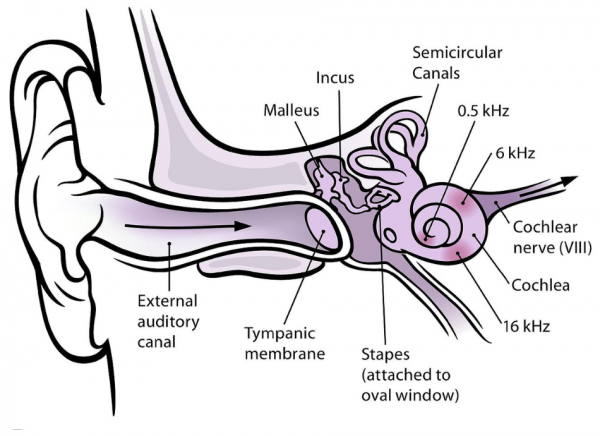Wishing everyone a safe and happy Christmas and New Year – Meri Kirihimete from the Healthify team.
Benign paroxysmal positional vertigo (BPPV)
Key points about benign paroxysmal positional vertigo (BPPV)
- Benign paroxysmal positional vertigo (BPPV) is an inner ear disorder, which can lead to sudden vertigo.
- Loose calcium crystals in your inner ear can cause dizziness when you move your head in certain directions. It's more common in people over the age of 40.
- The main symptom of BPPV is vertigo that is triggered by head movements.
- Vertigo in BPPV tends to last for less than a minute.
- BPPV is diagnosed by a special test called the Dix-Hallpike test.
- Treatment of BPPV includes the Epley Manoeuvre and Brandt-Daroff exercises.

Each of your ears has 3 parts: the outer ear, the middle ear and the inner ear. BPPV is a condition that affects your inner ear. Your inner ear includes the cochlea and semicircular canals. The cochlea helps with hearing, whereas the semicircular canals help with balancing and posture. The diagram (below) shows an example of the structure of your ear.

Image credit: Mike.lifeguard Wikimedia Commons
Your semicircular canals contain fluids that send signals to your brain when your head moves. These nerve signals tell your brain the movement and position of your head.
BPPV occurs when there are loose calcium crystals in the fluid of the semicircular canals of one ear, causing extra nerve signals or wrong signals to be sent to your brain. Your brain gets confused between these extra nerve signals and the normal nerve signals sent from your unaffected ear, resulting in vertigo.
It is not clear why some people have these loose calcium crystals, but it is thought to be related to increasing age, so BPPV is more common in people over the age of 40. You are also at higher risk of BPPV if you are a woman, suffer from a head or ear injury, or have had an infection in your inner ear.
The main symptom of BPPV is vertigo. Vertigo in BPPV is triggered by sudden changes in the position of your head, such as when you tip your head up or down, lie down, or turn over or sit up in bed. It tends to last for a minute or less and settles if you keep your head still. This is called an attack.
Other symptoms that you may have along with vertigo include dizziness and nausea. In between BPPV attacks, you are normally well.
Your doctor will ask you about your symptoms and their relation to any head movements. They will also find out whether you have other symptoms such as hearing loss or ear fullness to rule out another diagnosis.
No blood test is needed to diagnose BPPV, but your doctor may order some blood tests or further tests to rule out other conditions.
Your doctor will also examine your ears and eyes, check your balance and your nerves. The main diagnostic test is called the Dix-Hallpike test. It involves a health professional experienced in the treatment of benign paroxysmal positional vertigo (BPPV) carrying out a series of body and head manoeuvers to look for the ‘jumping’ of the eyes that's seen in people with BPPV. This test is called the Dix-Hallpike test and can be performed in the health professional’s rooms. It isn't painful but may bring on an attack of vertigo and possibly nausea and vomiting.
In the video below, Barry Snow, a neurologist at Auckland City Hospital, discusses a flow chart he has developed to help diagnose and determine the best treatment for vertigo, and demonstrates the Dix-Hallpike test for benign paroxysmal positional vertigo (BPPV).
Video: Hands-on Help: Barry Snow, Neurologist
This video may take a few moments to load.
(New Zealand Doctor, 2013)
Symptoms of BPPV can usually clear up themselves within a few weeks or months without treatment. However, treatment can include:
- the Epley Manoeuver
- Brandt-Daroff exercises.
Video: Vertigo - Epley manoeuvre from BMJ Learning
The Epley Manoeuver is a procedure that your doctor can perform on you. This manoeuvre aims to relocate the loose calcium crystals that are present in your semicircular canals. The process is similar to the Dix-Hallpike test with a few extra movements. Watch the video below to find out how a doctor performs the Epley Manoeuvre.
(BMJ Learning, UK, 2014)
Video: Brandt-Daroff exercises
Your doctor may recommend you to do some special exercises called Brandt-Daroff exercises. You need to do these exercises 2–3 times a day for about 6 weeks. These exercises involve your head turning and movement of your upper body.
Read more about Brandt-Daroff exercises(external link) or watch the video below about doing the Brandt-Daroff exercises.
(Physiotec, Canada, 2014)
Ask your doctor or physiotherapist about how to perform this exercise.
Apps reviewed by Healthify
You may find it useful to look at some vertigo apps.
Because vertigo in BPPV can affect your balance and may make you feel unsteady, you are at risk of falls or accidents.
To reduce your risk of a fall or accident:
- get out of your bed or chair slowly
- wear low-heeled shoes that fit properly
- use handrails on stairs
- install grab bars in the bathroom – don't use towel racks for balance
- use a shower stool and apply adhesive strips to the shower or tub floor
- use a walking aid if needed
- let your employer know about your symptoms, especially if your job involves operating machinery or climbing ladders.
If you have vertigo, it can be extremely dangerous to drive. It is important to let your doctor know so they can treat your BPPV accordingly.
It is also a legal requirement for you to drive only when medically fit, which means you should not drive if you are dizzy or experiencing vertigo. You will need to stop driving until your condition has been treated and you have no more attacks of vertigo.
|
See your GP as soon as possible if you feel very dizzy or are experiencing vertigo while driving, or if your job involves operating machinery or aircraft. |
The following links provide further information about BPPV. Be aware that websites from other countries may have information that differs from New Zealand recommendations.
Benign paroxysmal positional vertigo (BPPV)(external link) The NZ Society for Balance, Dizziness and Vertigo, NZ
Benign paroxysmal positional vertigo(external link) Patient Info, UK
Vertigo(external link) Health New Zealand | Te Whatu Ora, NZ
Benign paroxysmal positional vertigo (BPPV)(external link) Better Health Channel, Australia
Vertigo(external link) NHS, UK
Brandt-daroff exercises(external link) NHS, UK
Apps
References
- Benign paroxysmal positional vertigo(external link) Patient Info, UK
- Vertigo(external link) Auckland Regional HealthPathways, NZ, 2019
- A delicate balance: managing vertigo in general practice(external link) BPAC, NZ, 2012
- An approach to vertigo in general practice(external link) Australian Family Physician, 2016
Credits: Healthify editorial team. Healthify is brought to you by Health Navigator Charitable Trust.
Reviewed by: Dr Helen Kenealy, geriatrician and general physician, CMDHB
Last reviewed:
Page last updated:





